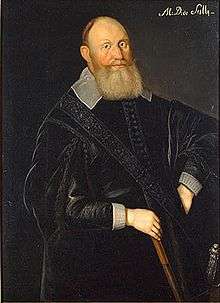Carl Gyllenhielm

Baron Carl Carlsson Gyllenhielm (4 March 1574 – 17 March 1650) was a Swedish soldier and politician. He was made a baron (friherre) in 1615, appointed Field Marshal in 1616, Privy Councilor in 1617, Governor General of Ingria in 1617 and served as Lord High Admiral from 1620 until his death.
He was an illegitimate son of Duke Carl, later King Charles IX of Sweden, and Karin Nilsdotter,[1] the daughter of a clergyman from Östergötland, and was raised at the royal estate of Julita in Södermanland. He was thus the older half-brother of King Gustavus Adolphus of Sweden. It was the tradition in Sweden in this period that noble children born out of wedlock were acknowledged by their fathers, as long as they were not the product of adultery. Carl Carlsson was ennobled in 1592 with the name Gyllenhielm and entered the service of the crown as a soldier. He served with the navy in the 1590s before moving to the army for the Swedish-Polish War (1600-11).
He was captured by the enemy in Poland in 1601, and remained a prisoner of war for twelve years. After attempting to escape, he was forced to wear leg irons for the last six and a half years of his captivity. He was freed in 1613, and shortly after raised to the rank of baron and field marshal by his half-brother. From 1617 he was governor general of the province of Ingria, until he returned to Sweden in 1620 to become Lord High Admiral. Admirals in this period were expected to lead the navy at sea as well as administrate, but Gyllenhielm did not often take command himself. He delegated much of the day-to-day business of the navy to Clas Fleming, and focused his naval efforts on overseeing the navy's finances. In September 1628, he served as the chairman of the tribunal convened to investigate the loss of the new warship Vasa (ship).
After the death of Gustavus Adolphus in 1632, Gyllenhielm was responsible for returning his half-brother's body to Sweden. In the following year, he was appointed to the regency government which ruled in the name of Queen Christina of Sweden during her minority, until 1644. He built a palace, Karlberg, to the northwest of Stockholm, and spent his last years there. He died at Karlberg on 17 March 1650, and was buried in Strängnäs church. Karlberg was eventually taken over as an administrative headquarters for the Swedish military, but several of the central reception rooms are preserved as they were in Gyllenhielm's lifetime.
References
Jan Glete (2010). Swedish Naval Administration: Resource flows and organizational capacity. Leiden: Brill.